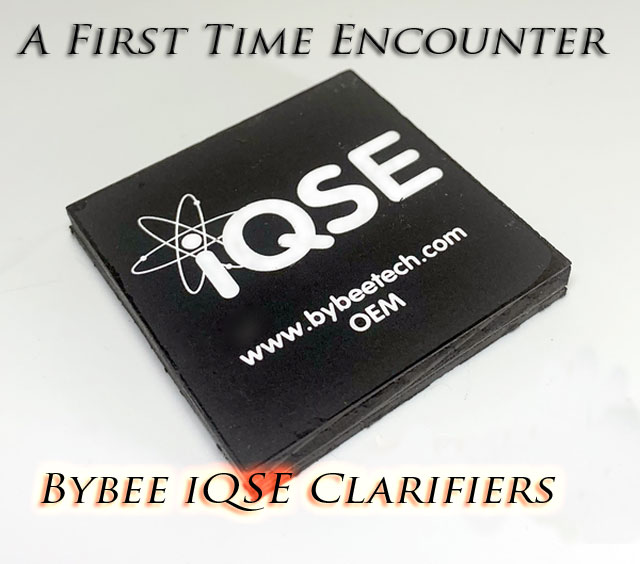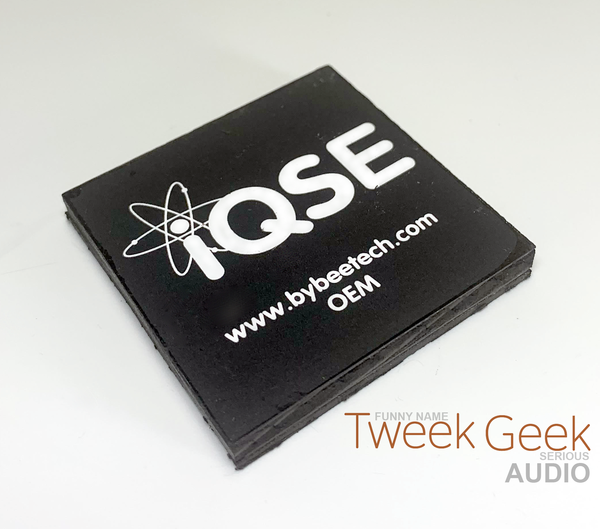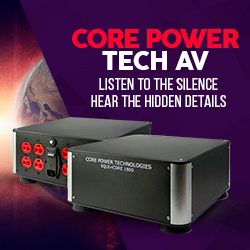Bybee iQSE Clarifiers: A First time Encounter

 This review follows that of Mr. Greg Voth’s, and unlike him, I cannot claim that I am starting from a clean slate in reviewing the Bybee iQSE Clarifiers. To the contrary, I am writing this review having the benefit of knowing in advance what others believe about the sound of these products. To a certain extent, I have to acknowledge that I was “primed” to think a certain way about how the iQSE’s Clarifiers would sound even before listening to them. That notwithstanding, after spending several weeks with these amazing products, I can honestly say I have been able to independently verify many of the attributes of sound that others have found so impressive.
This review follows that of Mr. Greg Voth’s, and unlike him, I cannot claim that I am starting from a clean slate in reviewing the Bybee iQSE Clarifiers. To the contrary, I am writing this review having the benefit of knowing in advance what others believe about the sound of these products. To a certain extent, I have to acknowledge that I was “primed” to think a certain way about how the iQSE’s Clarifiers would sound even before listening to them. That notwithstanding, after spending several weeks with these amazing products, I can honestly say I have been able to independently verify many of the attributes of sound that others have found so impressive.
 Physically, the iQSE Clarifiers are easy enough to describe. As noted by Greg, the Clarifiers are approximately 2 in. square and 1/4 in. thick. The Clarifiers themselves appear to be a dark laminate that is structurally similar to plywood. However, while dark, each layer of laminate exhibits a reddish metallic sheen depending on how it is held in the light. The laminate itself is sandwiched between a product label, and a thin magnet (for ease of installation). In truth, I have no idea what these devices are made of.
Physically, the iQSE Clarifiers are easy enough to describe. As noted by Greg, the Clarifiers are approximately 2 in. square and 1/4 in. thick. The Clarifiers themselves appear to be a dark laminate that is structurally similar to plywood. However, while dark, each layer of laminate exhibits a reddish metallic sheen depending on how it is held in the light. The laminate itself is sandwiched between a product label, and a thin magnet (for ease of installation). In truth, I have no idea what these devices are made of.
Categorically, I would characterize the iQSE Clarifiers as “system tweaks.” When it comes to an analog audio chain, experience suggests that everything matters. It’s difficult to understate the importance of finding components that work well together; ‘synergy’ is the oft overused though nevertheless appropriate term here. The products I refer to as “system tweaks” are those that help improve the integration and synergy between components.

Setup
The iQSE’s are not installed in the “audio chain” in the traditional sense. While they undoubtedly affect the sound of the audio chain, they cannot properly be considered a link in that chain. The iQSE Clarifiers (to the best of my knowledge) do not ever carry an audio signal like a speaker cable, or preamplifier would. Unlike many other audio products, it is easy to conceptualize how multiple iQSE’s could be used in aggregate for a cumulative effect. In fact, I am told the cumulative effects of more of these devices can be breathtaking.
The difficulty of installation can vary greatly depending upon the speakers used. According to Jack Bybee, the Clarifiers operate by reducing eddy current distortion and stray magnetic flux, and are used to the greatest effect when they are affixed directly to the speaker’s transducer. Moreover, they must be touching the transducer for maximum effect, so installations that are simply ‘near’ the transducer will not have the impact of a direct installation. Pragmatically speaking and for obvious reasons, some speakers are better candidates for transducer treatment than others.
 Fortunately, my reference system was easily able to accommodate quick installation of the iQSE Clarifiers. The system is built on a solid foundation with PS Audio’s DirectStream Power Plant 12, followed by a DirectStream DAC, and BHK Signature Preamplifier. Amplification is handled by the capable Pass Labs XA30.8, which drives a pair of Tekton Design Double Impacts.
Fortunately, my reference system was easily able to accommodate quick installation of the iQSE Clarifiers. The system is built on a solid foundation with PS Audio’s DirectStream Power Plant 12, followed by a DirectStream DAC, and BHK Signature Preamplifier. Amplification is handled by the capable Pass Labs XA30.8, which drives a pair of Tekton Design Double Impacts.
The scope of this review is limited to the effects of four iQSE Clarifiers placed directly on the Tekton Double Impact’s woofers. I opted for this configuration for a couple of reasons. First, the Clarifiers are easily attached to the woofer transducers via the rear bass ports. As described above, the woofers in the Double Impacts are supported from behind by wooden dowels. I found the best placement of the Clarifiers was to leave them resting on the wooden dowel, then use the magnet to affix the tile to the transducer. Second, and as a corollary to the first, such an installation made the A/B testing much easier, and faster.
The mid-bass speakers on the Double Impacts are also easily treatable, however, they do not offer the same convenience of placement as the woofers. Since the objective of this review is to describe the changes that the iQSE Clarifiers can bring to a pair of loudspeakers, the ease of moving the Clarifiers in and out of place was a substantial factor in the decision to test only the woofers. That said, I would expect analogous changes to the sound in the mid-bass speakers as well.
In speaking to Mr. Bybee I learned his research supports the proposition of a cumulative effect of adding more iQSE’s to an audio system. While I only had four iQSE Clarifiers to review, I can imagine how treatment of all 8 speakers on the Tekton Double Impacts would sound. Beyond that, the evidence suggests that even greater effect can be heard through strategic placement of Clarifiers on other parts of the system as well. While the typical user will realize greater benefits through adding more Clarifiers to a system, Mr. Bybee was unable to opine what the saturation point might be.
The Sound
 As the saying goes, “you can’t make a silk purse out of a sow’s ear.” This pithy proverb seems somehow appropriate for describing the performance aspects of the iQSE Clarifiers. While the iQSE’s may not fix all of the problems in an otherwise discordant stereo system, they do have the ability to add some real magic to a synergistic system.
As the saying goes, “you can’t make a silk purse out of a sow’s ear.” This pithy proverb seems somehow appropriate for describing the performance aspects of the iQSE Clarifiers. While the iQSE’s may not fix all of the problems in an otherwise discordant stereo system, they do have the ability to add some real magic to a synergistic system.
The objective effects of placing the iQSE Clarifiers on the Double Impact woofers were repeatable, measurable, and undeniable. Using a microphone, I was able to detect measurable, yet modest, increases in the bass levels coming from the woofers when playing various test tones. Interestingly, the iQSE’s also seemed to alter the harmonic overtones coming from the woofers as well. However, despite the increase in bass output, the iQSE’s will not trick you into believing that you have just installed a subwoofer in your system. On the contrary, I found the improvements more evident in the qualitative aspects of the bass.
While anecdotally interesting, my objective tests were not sophisticated enough to draw any meaningful conclusions about how the iQSE’s sounded; for that, I used my ears! The benefits of the iQSE Clarifiers revolve around the quality of bass, not the quantity. Qualitatively, I found the music sounded fuller, the color and tone improved, and the bass had an overall wetter sound to it.
 The Pass Labs XA30.8 has been one of the most extensively reviewed audio amplifiers of the 2010’s. While it does have shortcomings, you will be hard-pressed to find anyone describe it as being dry or pale. Yet in contrast to having the iQSE Clarifiers installed, removing them left the sound drier, paler, and less interesting. The bass seemed thinner, restrained, and less impactful. Most importantly, there seemed to be less of that certain ‘magic’ in the music that compels further listening late into the night.
The Pass Labs XA30.8 has been one of the most extensively reviewed audio amplifiers of the 2010’s. While it does have shortcomings, you will be hard-pressed to find anyone describe it as being dry or pale. Yet in contrast to having the iQSE Clarifiers installed, removing them left the sound drier, paler, and less interesting. The bass seemed thinner, restrained, and less impactful. Most importantly, there seemed to be less of that certain ‘magic’ in the music that compels further listening late into the night.
Martin Tingvall’s 2019 release by SKIP Records, “The Rocket,” is becoming one of my favorites for piano solos. This album was recorded for the “they are here” kind of experience, and presents the piano in a very life-like manner. For example, “Rocket III” starts slowly with a delicate and repetitive melody, then about a minute into the track the music explodes with a full and sonorous sound as Tingvall hammers the lower register keys. Here the iQSE Clarifiers really bring out the full tone and bloom of those low notes that fills the room in a very visceral way. Beautiful.
 Similarly, John Mayer’s 2017 release by Columbia, “The Search for Everything,” showcases Mayer’s ability to craft beautifully layered and soulful tracks. “Moving on and Getting Over” is quick and light, with the reminiscent feel of 70’s funk. With the iQSE Clarifiers installed, the nimble bass line is fuller with more of the magic that really draws in the listener. Here, the iQSE’s demonstrate an ability to make a musical piece more interesting, even after a long day of listening.
Similarly, John Mayer’s 2017 release by Columbia, “The Search for Everything,” showcases Mayer’s ability to craft beautifully layered and soulful tracks. “Moving on and Getting Over” is quick and light, with the reminiscent feel of 70’s funk. With the iQSE Clarifiers installed, the nimble bass line is fuller with more of the magic that really draws in the listener. Here, the iQSE’s demonstrate an ability to make a musical piece more interesting, even after a long day of listening.
Final Thoughts
The iQSE Clarifiers represent an opportunity for an improvement in sound, with virtually no negative trade-off’s. For systems with strong synergy, achieving incremental improvement through traditional means usually involves trading up for more expensive components. Depending on the system at issue, the iQSE’s may represent one of the most cost effective ways to achieve the same improvements in sound as a substantial component upgrade.
The Tekton Double Impacts are an example of a speaker that represent a significant value in home audio. Are they the be-all-end-all speaker? Probably not. However, because of their cost-to-performance ratio, finding a speaker that will outperform them will likely come at significant expense. In situations like this, the iQSE’s may be the perfect way to upgrade before biting the bullet on that next big speaker purchase.
At some level, reviews like this help others determine whether an investment in the product is “worth it.” But, the cost-benefit analysis is unique, not only to each individual’s stereo system, but also to each individual’s circumstances. Products like the iQSE’s become compelling upgrade paths from a cost-benefit standpoint when you consider doubling or tripling the cost of components (speakers for example) for a similar improvement. I would submit that the Bybee iQSE Clarifiers are worthy of your consideration. 
Richard Willie

One thought on "Bybee iQSE Clarifiers: A First time Encounter"
Leave a Reply
Stereo Times Masthead
Publisher/Founder
Clement Perry
Editor
Dave Thomas
Senior Editors
Frank Alles, Mike Girardi, Russell Lichter, Terry London, Moreno Mitchell, Paul Szabady, Bill Wells, Mike Wright, and Stephen Yan,
Current Contributors
David Abramson, Tim Barrall, Dave Allison, Ron Cook, Lewis Dardick, John Hoffman, Dan Secula, Don Shaulis, Greg Simmons, Eric Teh, Greg Voth, Richard Willie, Ed Van Winkle, Rob Dockery, Richard Doron, and Daveed Turek
Site Management Clement Perry
Ad Designer: Martin Perry





I’m tempted to try them. The obvious question is, if they really do work to improve the sound of a speaker, then why don’t speaker manufacture’s just add them to their speakers. I’ll probably buy a pair just to satisfy my own curiosity and hopefully will be pleasantly surprised.